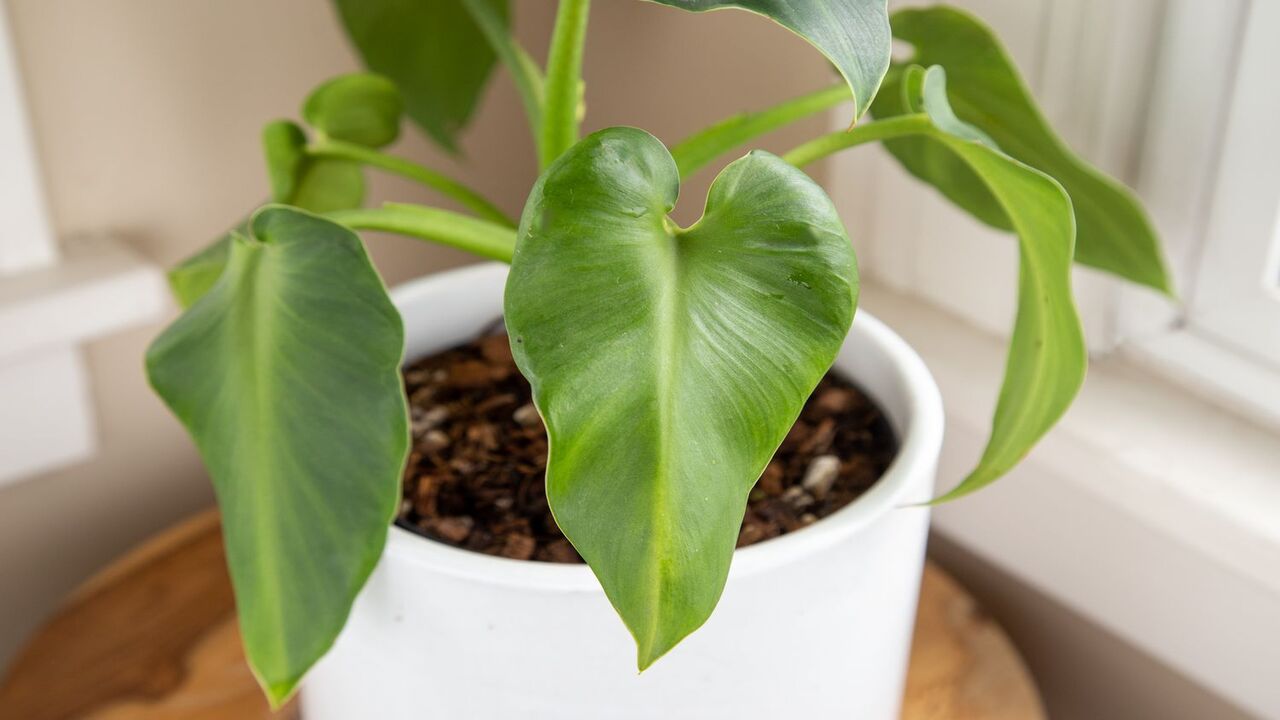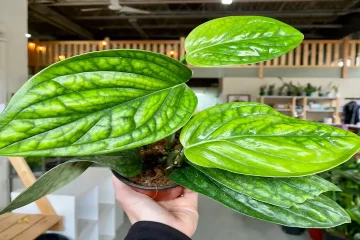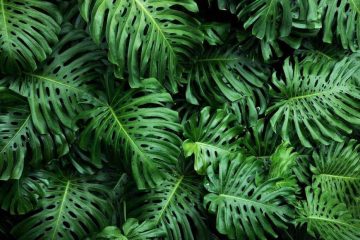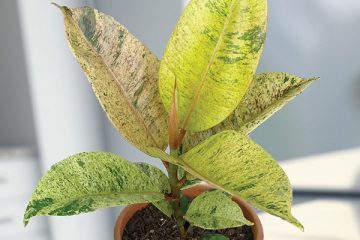So, you’ve got yourself a Philodendron Rugosum, huh? Well, let me tell you, you’re in for a treat! With its unique velvety leaves and charmingly rugged appearance, this plant is a real showstopper in any indoor jungle. But hey, before you dive headfirst into caring for it, let’s talk strategy. Philodendron Rugosum isn’t too demanding, but it does have its quirks. From lighting preferences to watering habits, there’s a lot to cover. So grab your gardening gloves and get ready to learn how to pamper your Rugosum to perfection with Plants Fiesta
| Common Name | Pigskin philodendron, Sow’s ear plant |
|---|---|
| Botanical Name | Philodendron Rugosum |
| Family | Araceae |
| Plant Type | Vine, Perennial |
| Mature Size | Up to 15 feet tall outdoors |
| Sun Exposure | Sun, Partial Shade |
| Soil Type | Well-drained |
| Soil pH | Acidic, Neutral |
| Bloom Time | Spring (but rarely flowers indoors) |
| Flower Color | White |
| Hardiness Zones | 9-11 (USDA) |
| Native Area | South America |
| Toxicity | Toxic to pets and people |
How To Grow & Care Philodendron Rugosum
Philodendron rugosum is a beautiful and unique species of Philodendron known for its velvety leaves and interesting texture. Here are some tips for growing and caring for Philodendron rugosum:
- Light: Philodendron rugosum prefers bright, indirect light. Avoid direct sunlight as it can scorch the leaves. A north or east-facing window is ideal, where it can receive bright, filtered light.
- Temperature: Keep the temperature consistently warm, ideally between 65°F to 80°F (18°C to 27°C). Avoid exposing the plant to temperatures below 50°F (10°C).
- Humidity: Philodendron rugosum appreciates higher humidity levels. You can increase humidity by misting the leaves regularly, placing the plant on a tray filled with pebbles and water, or using a humidifier.
- Watering: Water your Philodendron rugosum when the top inch of the soil feels dry to the touch. Ensure that the pot has good drainage to prevent waterlogging, which can lead to root rot. During winter or cooler months, reduce watering frequency as the plant’s growth slows down.
- Soil: Use a well-draining, peat-based potting mix for your Philodendron rugosum. You can also add perlite or orchid bark to improve drainage.
- Fertilization: Feed your Philodendron rugosum with a balanced liquid fertilizer diluted to half strength every 4-6 weeks during the growing season (spring and summer). Avoid fertilizing during the winter months when growth slows down.
- Pruning: Regularly remove any yellowing or dead leaves to maintain the plant’s health and appearance. You can also trim leggy stems to encourage bushier growth.
- Support: As Philodendron rugosum grows, it may benefit from a moss pole or trellis for support. This will help the plant climb and maintain its upright growth habit.
- Pests and Diseases: Keep an eye out for common houseplant pests like spider mites, aphids, and mealybugs. If you notice any pests, treat them promptly with insecticidal soap or neem oil. Ensure good air circulation around the plant to prevent fungal diseases.
- Repotting: Repot your Philodendron rugosum into a slightly larger pot every 1-2 years or when it becomes root-bound. Spring is the best time for repotting, as it allows the plant to recover and establish itself before the active growing season.
By following these care tips, you can help your Philodendron rugosum thrive and grow into a stunning addition to your indoor plant collection.
Philodendron Rugosum Price
In the USA, the price of Philodendron rugosum typically ranges from $40 to $80, depending on factors such as plant size, overall health, and rarity. This philodendron species is sought after by plant enthusiasts for its unique textured foliage and attractive appearance, contributing to its higher price point compared to more common houseplants. Prices may vary between different sellers, nurseries, and online retailers. Larger, more mature specimens or those with particularly striking foliage patterns may command higher prices. As with any plant purchase, the price can also be influenced by local market conditions and availability.
Philodendron Rugosum Propagation
Philodendron rugosum, like many other philodendron species, can be propagated through several methods, including stem cuttings, division, and air layering. Philodendron Rugosum and Ficus Shivereana species can be propagated through stem cuttings, allowing gardeners to create new plants from existing ones. This makes them popular choices for propagation enthusiasts and those looking to expand their plant collection.Here’s how you can propagate Philodendron rugosum through stem cuttings:
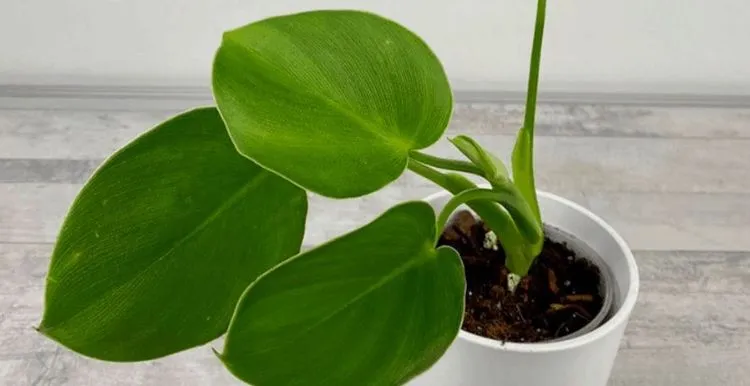
Selecting a Healthy Parent Plant:
Choosing a healthy parent plant is crucial for successful propagation. Look for a Philodendron rugosum plant that is free from diseases, pests, and physical damage. Select a plant that exhibits vigorous growth with vibrant leaves and sturdy stems. Avoid plants that show signs of stress, such as yellowing leaves or wilting. Additionally, ensure that the parent plant has several stems from which you can take cuttings, as this will not only promote healthy growth but also allow you to propagate multiple new plants.
Preparing the Cutting:
Once you’ve identified a suitable parent plant, it’s time to prepare the cutting. Use a clean, sharp knife or scissors to make a clean cut just below a node on one of the stems. Nodes are where leaves emerge from the stem and are essential for root development. Cuttings should ideally be 4-6 inches long and include at least one node and leaf. If desired, you can remove the lower leaves from the cutting to expose the node, which can encourage faster root growth.
Rooting Hormone (Optional):
While not necessary, some gardeners choose to use rooting hormone to promote root development in cuttings. Rooting hormone is available in powder, gel, or liquid form and contains growth-promoting hormones that stimulate root growth. To use rooting hormone, simply dip the cut end of the stem into the hormone, ensuring that the node is fully coated. Shake off any excess hormone before planting the cutting in the potting mix.
Planting the Cutting:
Fill a small pot with well-draining potting mix, such as a combination of perlite, peat moss, and coarse sand. Make a hole in the soil with your finger or a pencil and gently insert the cutting into the hole. Firm the soil around the cutting to provide support and ensure good soil-to-stem contact. If planting multiple cuttings in the same pot, space them evenly to prevent overcrowding. Water the soil lightly after planting to settle it around the cutting.
Provide Proper Conditions:
Place the pot in a warm, humid location with bright, indirect light. Ideal temperatures for rooting range from 70 to 80°F (21 to 27°C). Avoid placing the cutting in direct sunlight, as this can cause stress and inhibit root development. To maintain humidity, you can cover the pot with a clear plastic bag or place it in a propagation tray with a humidity dome. Check the soil moisture regularly and water as needed to keep the soil consistently moist but not waterlogged.
Monitor Growth:
Over the following weeks, monitor the cutting for signs of new growth and root development. You may notice new leaves emerging from the stem or changes in the appearance of existing leaves. To check for root growth, gently tug on the cutting after a few weeks. If you feel resistance, it indicates that roots have formed. Be patient during this stage, as root development can take several weeks to occur, depending on environmental conditions and the health of the cutting.
Transplanting:
Once the cutting has developed a healthy root system and new growth, typically after 6-8 weeks, it’s ready to be transplanted into a larger pot with regular potting soil. Choose a pot that is slightly larger than the current one to allow room for the plant to grow. Carefully remove the cutting from its original pot, taking care not to damage the roots, and place it in the center of the new pot. Fill in any gaps around the root ball with potting soil and water the plant thoroughly to settle the soil. Continue to care for the newly transplanted Philodendron rugosum by providing adequate light, water, and humidity.
Philodendron rugosum Benefits
Philodendron rugosum is a species of tropical plant belonging to the Araceae family. Philodendron Rugosum and Philodendron Melanochrysum belong to the genus Philodendron and the family Araceae. This places them within the same botanical classification.While there might be anecdotal claims about the benefits of Philodendron rugosum, it’s essential to note that any perceived benefits should be taken with caution and verified through scientific research. Here are some commonly mentioned benefits associated with Philodendron rugosum:
Air Purification:
Philodendron rugosum contributes to indoor air purification by removing pollutants like formaldehyde and benzene through a process known as phytoremediation. Its foliage absorbs these harmful compounds and metabolizes them into harmless byproducts, thus improving air quality. This natural air purification mechanism helps create a healthier indoor environment, particularly in spaces with limited ventilation or high levels of indoor pollutants. By incorporating Philodendron rugosum into indoor spaces, individuals can reduce their exposure to harmful chemicals and enjoy cleaner, fresher air.
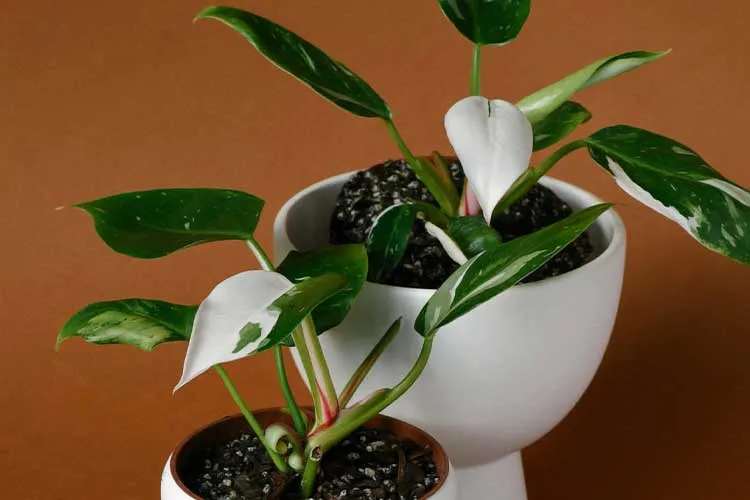
Aesthetics:
Philodendron rugosum is prized for its visually appealing foliage, featuring deep green leaves with unique textures and patterns. The plant’s lush and vibrant appearance adds a touch of natural beauty to indoor spaces, enhancing the overall aesthetic appeal of homes, offices, and other environments. Whether displayed in a pot on a windowsill, as part of a hanging basket arrangement, or incorporated into a larger indoor garden, Philodendron rugosum serves as a striking decorative element. Its foliage provides visual interest and texture, creating a sense of warmth and vitality in any setting.
Stress Reduction:
Caring for Philodendron rugosum can be a therapeutic and stress-relieving activity for many individuals. Engaging in gardening tasks such as watering, pruning, and repotting can promote relaxation and mindfulness, allowing people to unwind and reconnect with nature. The presence of indoor plants, including Philodendron rugosum, has been linked to reduced stress levels and improved mental well-being. The act of nurturing a living organism and watching it thrive can instill a sense of accomplishment and satisfaction, offering a welcome respite from the pressures of daily life. Incorporating Philodendron rugosum into indoor spaces can create a calming and tranquil atmosphere, providing a sanctuary for relaxation and stress relief.
Biophilic Benefits:
Philodendron rugosum supports biophilic design principles by bringing elements of nature into indoor environments. This connection with the natural world has been shown to have numerous benefits for human health and well-being, including reduced stress, increased productivity, and enhanced mood. By incorporating Philodendron rugosum into interior design schemes, individuals can create spaces that foster a greater sense of harmony and connection with nature. The plant’s lush foliage and organic forms evoke feelings of tranquility and vitality, promoting a sense of balance and well-being in indoor settings. Whether used in residential, commercial, or public spaces, Philodendron rugosum contributes to creating environments that are both aesthetically pleasing and psychologically uplifting.
Humidity Regulation:
Philodendron rugosum contributes to regulating indoor humidity levels by releasing moisture through transpiration. This process helps increase humidity in dry indoor environments, which can be particularly beneficial during winter or in regions with arid climates. Adequate humidity levels can prevent issues like dry skin, respiratory irritation, and static electricity buildup. By cultivating Philodendron rugosum indoors, individuals can create a more comfortable and balanced indoor environment conducive to overall well-being.
Natural Toxin Removal:
In addition to formaldehyde and benzene, Philodendron rugosum may help remove other indoor air pollutants such as xylene, toluene, and trichloroethylene. Through its leaves and roots, the plant absorbs and metabolizes these toxins, contributing to a cleaner and healthier indoor atmosphere. By incorporating Philodendron rugosum into indoor spaces, individuals can mitigate the potential health risks associated with indoor air pollution, promoting respiratory health and overall well-being.
Educational Tool:
Growing Philodendron rugosum indoors provides an opportunity for hands-on learning about plant care, botany, and ecology. It can be particularly educational for children or gardening beginners, fostering a deeper understanding and appreciation of nature. Observing the plant’s growth patterns, conducting experiments with watering and fertilization, and learning about its native habitat can enrich one’s knowledge and connection with the natural world. Philodendron rugosum serves as a living classroom, offering valuable lessons in plant biology and environmental stewardship.
Potential for Medicinal Use:
While scientific research specifically on the medicinal properties of Philodendron rugosum may be limited, various species within the Philodendron genus have been studied for their potential pharmacological properties. Some compounds found in Philodendron species have demonstrated antimicrobial, antioxidant, and anti-inflammatory properties in preliminary studies. While further research is needed to determine the therapeutic potential of Philodendron rugosum specifically, its cultivation may hold promise for future exploration in natural medicine and pharmaceutical development. As with any medicinal plant, it’s essential to consult with healthcare professionals before using Philodendron rugosum for medicinal purposes.
Philodendron rugosum Aberrant Form
let me tell you about the Philodendron rugosum aberrant form! It’s like the rebel of the plant world, sporting a quirky and unique appearance that’s quite different from the typical Philodendron rugosum. Instead of sticking to the standard leaf shape, this aberrant form throws caution to the wind with its wild and irregular foliage. It’s like nature’s little surprise, adding a fun twist to your indoor garden. With its unexpected charm, the Philodendron rugosum aberrant form is sure to catch the eye and spark conversation among plant enthusiasts. Who knows what delightful surprises it’ll bring to your home!
Philodendron rugosum Variegated
The Philodendron rugosum variegated is a stunning cultivar of the Philodendron rugosum species, renowned for its mesmerizing foliage. Unlike the standard variety, this variant boasts leaves adorned with striking patterns of variegation, featuring patches, streaks, or marbling of contrasting colors such as white, cream, or yellow, alongside the traditional deep green hues. Its captivating appearance adds a touch of elegance and sophistication to any indoor garden or living space. With its unique blend of colors and textures, the Philodendron rugosum variegated is sure to steal the spotlight and become a cherished centerpiece in your botanical collection.
Common Pests & Plant Diseases OF Philodendron rugosum
Following are the common pests and plant diseases of Philodendron rugosum that you must know:
Common Pests:
- Spider Mites: Spider mites are tiny arachnids that commonly infest Philodendron rugosum. These pests feed on the plant’s sap by piercing the leaves with their mouthparts, causing stippling, yellowing, and eventually leaf drop. Spider mite infestations can also lead to the development of fine webbing on the undersides of leaves, which further damages the plant. Controlling spider mites often requires regular inspection of the plant, followed by treatment with insecticidal soap or horticultural oil to suffocate and kill the pests.
- Mealybugs: Mealybugs are soft-bodied insects covered in a white, cottony substance. They feed on the sap of Philodendron rugosum, causing the leaves to become distorted and yellowed. Additionally, mealybug infestations can lead to the production of sticky honeydew, which attracts ants and promotes the growth of sooty mold. Managing mealybugs involves manually removing the insects with a cotton swab dipped in rubbing alcohol or applying insecticidal soap to eliminate them.
- Scale Insects: Scale insects are small, oval-shaped pests that attach themselves to the stems and leaves of Philodendron rugosum. They feed on the plant’s sap, causing wilting, yellowing, and stunted growth. Scale infestations can be challenging to control due to their protective waxy coating, which shields them from many pesticides. However, systemic insecticides or horticultural oil applications can effectively manage scale populations by suffocating and killing the pests.
- Aphids: Aphids are small, soft-bodied insects that feed on the sap of Philodendron rugosum, causing leaves to curl, distort, and yellow. Additionally, aphids excrete a sugary substance called honeydew, which can attract ants and promote the growth of sooty mold. Controlling aphids often involves spraying the affected plant with a strong stream of water to dislodge the pests or applying insecticidal soap to eliminate them.
- Thrips: Thrips are slender insects that feed on the leaves of Philodendron rugosum, causing stippling, distortion, and silvering of foliage. They damage the plant by scraping the surface of leaves and sucking out the cell contents, leading to weakened and disfigured growth. Managing thrips typically involves using insecticidal soaps or neem oil sprays to control populations and prevent further damage to the plant.
Common Diseases:
- Root Rot: Root rot is a fungal disease that affects Philodendron rugosum when the soil remains consistently waterlogged or poorly drained. The fungus thrives in soggy conditions, causing the roots to rot and decay. Symptoms of root rot include yellowing, wilting, and mushy roots. To prevent root rot, it’s essential to ensure proper drainage by using well-draining soil and avoiding overwatering.
- Leaf Spot: Leaf spot is a fungal disease that manifests as dark, circular lesions on the leaves of Philodendron rugosum. These spots may vary in size and color, eventually leading to leaf yellowing, wilting, and defoliation. Leaf spot can spread rapidly in humid environments or when plants are overcrowded. To control leaf spot, it’s important to remove and destroy infected leaves and improve air circulation around the plant.
- Bacterial Blight: Bacterial blight is a bacterial disease that affects Philodendron rugosum, causing water-soaked lesions on leaves, followed by wilting, browning, and dieback of affected foliage. The bacteria thrive in moist conditions and can spread through splashing water or contaminated tools. To manage bacterial blight, it’s essential to avoid overhead watering, remove and destroy infected plant parts, and treat with copper-based fungicides.
- Powdery Mildew: Powdery mildew is a fungal disease characterized by the development of white, powdery growth on the leaves of Philodendron rugosum. This fungal growth can spread rapidly in warm, humid conditions, causing leaf distortion, yellowing, and premature leaf drop. To control powdery mildew, it’s important to improve air circulation around the plant, avoid overhead watering, and apply fungicidal sprays containing sulfur or potassium bicarbonate.
- Anthracnose: Anthracnose is a fungal disease that affects Philodendron rugosum, causing dark, sunken lesions on leaves, stems, and petioles. These lesions may expand over time, leading to leaf drop and dieback of affected plant parts. Anthracnose thrives in warm, moist conditions and can spread rapidly during periods of high humidity. To manage anthracnose, it’s essential to remove and destroy infected plant material, improve air circulation, and apply fungicidal sprays containing copper or chlorothalonil. Regular monitoring and proper plant care practices can help prevent and mitigate the impact of these common diseases on Philodendron rugosum.

